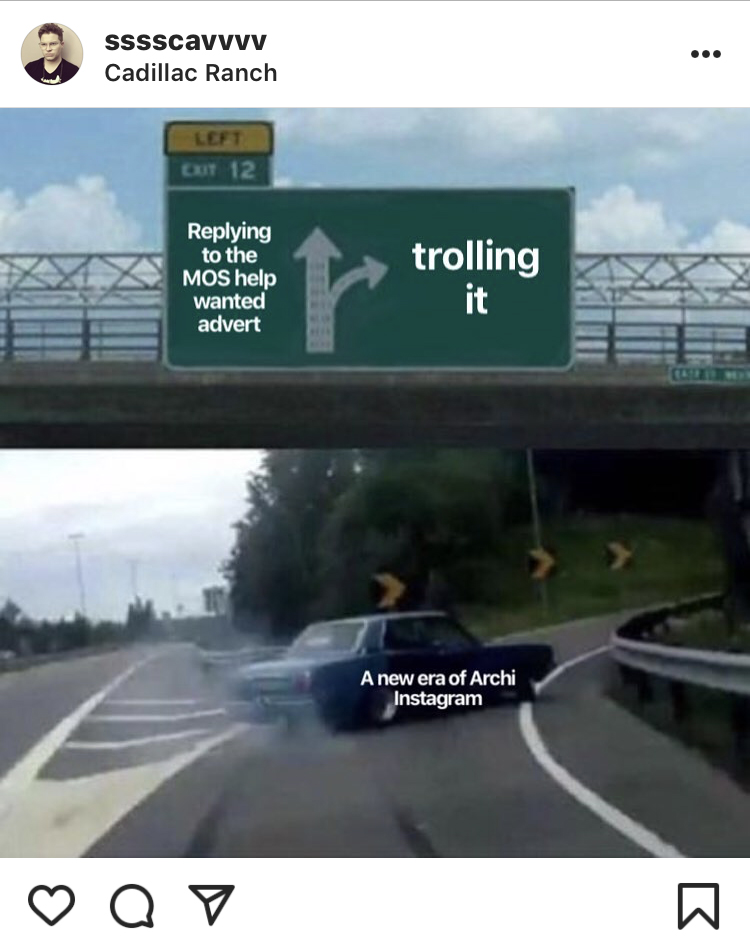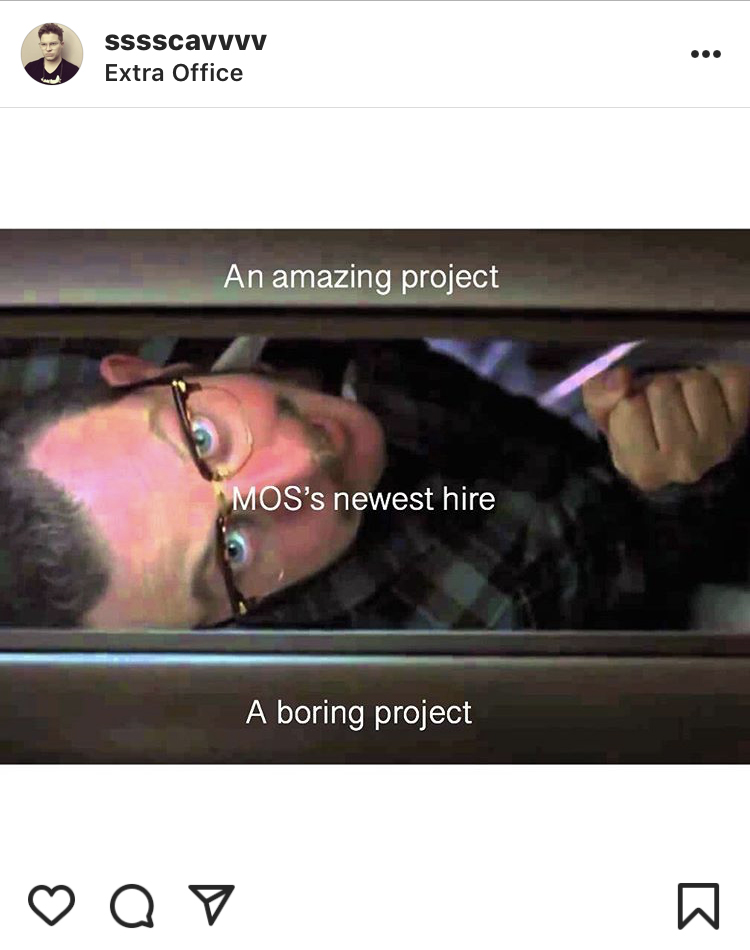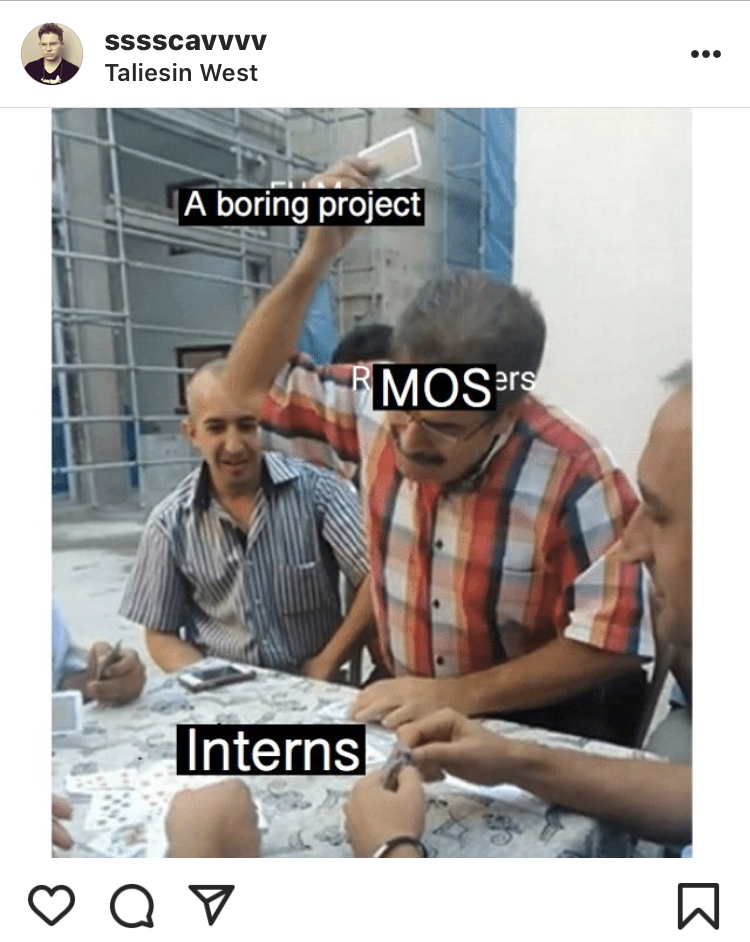An Interview With Ryan Scavnicky
“Slim Jim, Chipotle, and Totino's understand social media better than Bjarke Ingels, OMA, or Gensler lol”
Ryan Scavnicky is a Teaching Fellow at the School of Architecture at Taliesin and the founder of Extra Office. He makes architectural memes on Instagram as @sssscavvvv.
How does your meme production relate to prior and current architectural production? Do they inform each other?
I consider Stanley Tigerman’s The Titanic (1978) to be the first architecture meme. This image itself is critical of the Miesian project by representing it as a sinking ship. It provides commentary without language. I don’t go back and use these types of images because they would probably be too arcane for today’s audience.
I have a beef with current architectural production as it relates to its dissemination via social media. Most firms, students, and schools use the medium to simply post pictures of floor plans, renderings, or what they think is the work. But that isn’t really what the medium is for. The idea of Instagram strictly being a visual diary is naïve and self-serving. It is a platform for the exchange of experience, identity, and politics through the image. Posting pretty work is a miniscule possibility of this medium. I think architecture need not restrict itself to translating its work into another medium by using the work directly. Instead, architects should make new content specifically meant for the medium in which it will be disseminated.
Slim Jim, Chipotle, and Totino's understand social media better than Bjarke Ingels, OMA, or Gensler lol.
Stanley Tigerman, The Titanic, 1978. Courtesy The Art Institute of Chicago.
To what extent are the memes you make a serious response to current architecture discourses? What are the conditions, or terms, of these discourses that you disagree with and seek to change?
I like to ask: how can we have a discourse without constantly testing the border between it and the broader public? The discipline has always existed in multiple mediums. As communication tools rapidly diversify we should test these new channels and their ability to hold content, not stick to strictly writing long-form texts. Doesn’t discourse assume that multiple authors are having a productive conversation? I see too many architecture articles online with zero comments and publications in need of patronage to believe that we are more interested in conversation than self-promotion.
How do you use memes in your teaching, if at all? Is it a pedagogical tool, or something that gets discussed more informally?
Yeah this is a hard question. At the beginning it was only informal, but it is slowly working more phrases and links back into the studio—and the desk crit conversation—that helps a student make important linguistic connections. I am interested in working with this question in the future.
The first PhD in internet memes was awarded in 2014, so there is a lot of territory here to explore. I expect them to continue to find their way into the design studio, and the hope is that it is not just my own studio where they pop up but around the world. Eventually they may become a tool for defending or ending trends.
How do you think memetic thinking could be more productively utilized in architectural education? In reference-heavy studio conversation (“this Herzog stair, that Caruso St. John facade”), aren’t we already thinking in memes?
We are already thinking in memes. The traditional definition of a meme is any unit of cultural transmission and is distinct from the internet meme as the category of images we are discussing today. Memes themselves pervade all cultures and histories from Orion to the Harlem Shake. We’ve already been teaching architecture as a series of “memes” or “problems” in a way, and a good history course should allow students to read architecture and make these links while opening up new histories and room for strange loops to occur. Think about the “corner problem” or a recent fascination with noodles, etc.
How do you think about memes in relation to the history of architecture? There are examples of people using themes to organize surveys of architectural knowledge. We think about Rem’s Elements theme at the Venice Biennale, Adrian Forty’s Words and Buildings, Rosalind Krauss’ discussion on aesthetic mediums in Under Blue Clip, or, more recently, Ana Miljacki’s fantastic collection Under the Influence. Is this not enough? How are memes even more powerful than the stuff offered by these authors?
My goal is not to undermine these factions of knowledge production but to reverberate them into the world in more useful ways. I’m not trying to replace scholarship, or even writing in general, but to activate that knowledge. Memes (cultural knowledge) are only useful as far as they can be easily understood and repeated.
Memes, as you’ve pointed out, are communicative routes into and out of the discipline. They enable expression in a more general cultural arena. How do you see this strengthened connection between architectural culture and culture generally as useful?
Architects play games with one another inside of a much larger game. We constantly anticipate affecting this larger game, but need to be recognized as a player in order for us to participate. We have to understand the cultural landscape around us in order to affect that landscape.
It doesn’t seem like you’re concerned with architectural memes “watering down” the way we think about architecture. What would you say to people who might be concerned?
We’ve been reducing knowledge for years. Those who might be concerned should read this article in The Guardian about memes being the battlegrounds of future warfare. Maybe then the concerns might shift.
Memes have precedence in political cartoons, a format in which critique is both sharp and funny at the same time. How can architecture memes address the politics embedded in the discipline in useful ways?
To make memes is already a political act as it brings thought and communication from an inside group to an outside group. This action either exposes the inside group as exaggerating their sophistication or it allows for wider participation in what have been historically closed conversations; this opening has political consequences.
To paraphrase Frank Zappa’s own question about funny music: Does humor belong in architecture? You’ve written that you think the discipline takes itself too seriously. Why is that?
Architecture takes itself seriously because it is a serious act with serious implications. But sometimes taking a funny approach to something serious—like Dan Laszlo’s book Prostate Cancer is (Not) Funny—can cause a bit of relief. I feel humor should play a bigger part in how we talk about ourselves and what we do together. If you get the chance to meet infamous architecture critics personally, I think they are hilarious people. So, for the most part this attitude already exists; I am simply making light of it.
Making memes is a very fast act of critique. How important is speed in criticism? It’s like timing for a comedian.
Of course, yes. Instagram doesn’t sleep. It is always awake and working. That is the toughest part of it all, personally.
I was migrating from Spring Green, Wisconsin to Scottsdale, Arizona as part of my teaching appointment with the School of Architecture at Taliesin and stopped in Amarillo, Texas, to see Cadillac Ranch. When I checked my phone, I saw MOS posted a job opening and SO-IL reposted an edited version of it. I had to respond to it right then and there, much to the chagrin of my spouse and two cats who were ready to get back on the road.





If stand-up comedians and late night television hosts are the most effective critics today, who are some that inspire you?
Great question. I felt a few years ago that Jon Stewart, Trevor Noah, and John Oliver were doing incredible work. However, it feels like it is impossible to parody anything in 2019 since the actual news has become less like news and more like reality TV. So those forms of criticism have lost some effect.
Today I have a lot of hope for the work being done by critics and parafictional artists like @TrueWagner, @ObviousPlant, @TonyZaret, @arthandlermag, and @bradtroemel.
To steal from Zappa again… “Architectural criticism isn’t dead, it just smells funny,” meaning that it seems to be read seriously by a small number of people and is written seriously by an even smaller number of people. How do you see memes as opening a new space of critique? Is it about audience for you? Or new mediums? Or a chance to be funny?
It is not just a chance to be funny. I think I am funny about a lot of things and architecture is really hard to be funny about. Most architecture humor I find in the wild is the same bland jokes over again: no sleep, finalfinal.psd, laser cutter broke on review day, etc. Memes open up new space of critique by forming positions legible to a larger audience than “just” architects. It isn’t only about being funny, but producing positions in faster mediums.
Wait. Who do you understand as your audience in this work?
Ah that's the exact question! The audience itself is the thing I test with each position. Who is “in” on the joke is constantly changing. This is where it starts to become research. Some joke that is super niche may not get as many likes while a legible criticism can explode. This is the border between the discipline and the broader public.
Tell us about the “McDonalds! McDonalds! McDonalds!” meme. In what ways was it a turning point for you, as you described it on Archinect?
It seemed to be the first time a meme format from outside of architecture was forced to hold architectural content and the mix worked really well, so well that it opened new ground. I mean, who would’ve said from the start, “What architects would willingly take their children to McDonalds?” It wouldn’t make sense. But the meme opened up that territory and reflected in a strange way the tendencies of the designers in the diagram.
You started writing “Extra, Extra,” a new column for Archinect. How do you intend to use that longer format platform to work on your ideas?
The meme isn’t supposed to replace longform dialogue for me. Plus, it isn’t research if you don’t reflect on it. The column is a chance to do this informally while I cycle my work into eventual scholarship. What memes really lack is the ability to backup mere opinions. As such, they are the perfect hosts for fake news, gossip, etc. as they enabled the formation of consensus based on belief alone. But isn’t all scholarship formed through some kind of consensus?
Meme culture reboots every fifteen minutes or so. It’s fast, and architecture is slow. Where is architectural meme culture going? Where do you want it to go?
At a certain point there are going to be 20, 50, or 100 architecture meme accounts. It is going to be overwhelming. I hope that memes cultivate more thoughtful dialogue rather than just jokes or making fun of famous designers. I hope it remains productive. After all, if someone has a position but doesn’t care to be productive, they are only self-promoting.
We’re asking everybody this… How do you communicate mood?
Emoji :)






